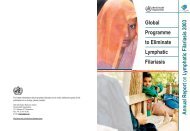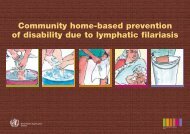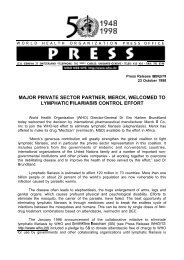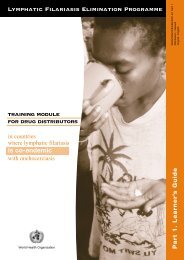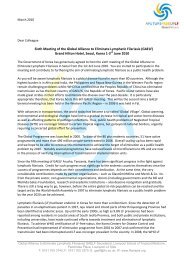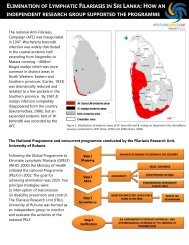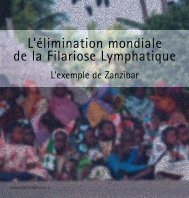English - Global Alliance to Eliminate Lymphatic Filariasis
English - Global Alliance to Eliminate Lymphatic Filariasis
English - Global Alliance to Eliminate Lymphatic Filariasis
You also want an ePaper? Increase the reach of your titles
YUMPU automatically turns print PDFs into web optimized ePapers that Google loves.
REPORT OF THE 6 TH GAELF MEETING, JUNE 2010<br />
used a flexible and comprehensive group<br />
decision-making method that was<br />
representative of all stakeholders.<br />
The participants drafted detailed<br />
“problem statements” for several key<br />
issues (e.g., footwear), which addressed<br />
current needs, requirements, and<br />
specifications. The conference organizers<br />
are planning <strong>to</strong> hold a consensus<br />
conference in the fall of 2010 and <strong>to</strong> begin<br />
producing and using standardized<br />
technical <strong>to</strong>ols in<br />
2011.<br />
Hydrocele Surgery<br />
Dr Serigne Magueye<br />
Gueye, Professor and<br />
Chair of Urology,<br />
University of Cheikh<br />
Anta in Dakar, Senegal,<br />
updated the GAELF on the West African LF<br />
Morbidity Management Programme,<br />
which helps <strong>to</strong> train and equip surgeons <strong>to</strong><br />
repair hydrocele, the most common<br />
chronic manifestation of bancroftian<br />
filariasis. He explained why surgery that<br />
spares the hydrocele sac may result in<br />
suboptimal outcomes in LF-endemic<br />
areas, and summarized key points for<br />
hydrocele surgery recommended by the<br />
programme. These include proper preoperative<br />
evaluation <strong>to</strong> exclude scrotal<br />
lymphoedema; the use of local<br />
anesthesia; an approach that uses a<br />
midline incision; meticulous hemostasis;<br />
proper post-operative dressing and<br />
bandaging; and<br />
complete resection of<br />
the hydrocele sac.<br />
The West Africa LF<br />
Morbidity<br />
Management<br />
Programme has had<br />
considerable success.<br />
Some 3874 surgeries<br />
were performed during<br />
training courses, which have taken place<br />
in 11 countries. 415 health workers have<br />
been trained, and the work has been<br />
highlighted at major international urology<br />
meetings. The programme also provided<br />
training in connection with the President<br />
Kikwete Fund for hydrocele surgery in<br />
Tanzania.<br />
To expand access <strong>to</strong> surgery for men with<br />
hydrocele in LF-endemic areas, it will be<br />
necessary <strong>to</strong> reposition LF within national<br />
health plans and <strong>to</strong><br />
increase training and<br />
research through a<br />
network of public and<br />
private partners, including<br />
universities, United<br />
Nations (UN) agencies,<br />
and NGDOs.<br />
In conclusion, Professor<br />
Gueye stressed that hydrocele surgery can<br />
be done even in remote areas, as long as<br />
there is adequate training. He called for<br />
the establishment of a broader network<br />
for morbidity management and training,<br />
as well as a GAELF Morbidity Management<br />
Expert Group.<br />
Economic and Psychosocial Impact of<br />
Hydrocele and the Benefits of<br />
Hydrocelec<strong>to</strong>my<br />
Professor John Gyapong, Direc<strong>to</strong>r,<br />
Research Development Division, Ghana<br />
Health Service, presented preliminary<br />
results of a study now underway in Ghana,<br />
where hydrocele is a<br />
public health problem.<br />
In 2006, 9,931 cases of<br />
hydrocele were<br />
registered in the<br />
country. Several<br />
studies have shown the<br />
negative effect of<br />
hydrocele on<br />
productivity and quality<br />
29



